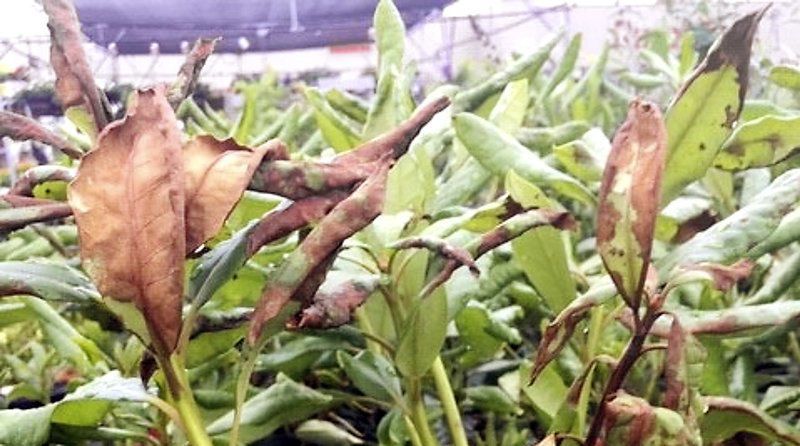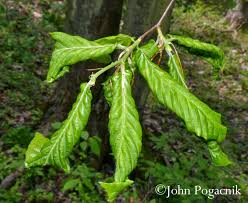
photo by Indiana Department of Natural Resources
Sudden oak death (SOD) (Phytophthora ramorum)
As I reported in June, Indiana officials had detected the pathogen that attacks more than 100 plant species and that causes sudden oak death in shipments of rhododendron plants from two nurseries in Washington State and British Columbia.
After an unexplained delay, USDA APHIS finally issued an official statement (reported on here) on the situation. Shipments of potentially infected plants already had been sent to 18 states — Alabama, Arkansas, Iowa, Illinois, Indiana, Kansas, Kentucky, Michigan, Missouri, Nebraska, North Carolina, Ohio, Oklahoma, Pennsylvania, Tennessee, Texas, Virginia, and West Virginia. Through “trace forward” inspections, eight of those states have confirmed that their plant retailers received infected plants — Iowa, Illinois, Indiana, Kansas, Missouri, Nebraska, Oklahoma, and Washington.
Plants that test positive for P. ramorum are being destroyed. All plants that have been kept within a two meter radius of an infected plant are also being destroyed. Host plants outside the two meter radius will be sampled intensively.
In addition, several major retailers have agreed to initiate a voluntary recall of plants from their stores.
APHIS advises people in these eighteen states who have bought a rhododendron from a retail outlet to monitor the plant for signs of disease, including leaf spots and shoot dieback. (APHIS provides no reference to a reliable on-line source of information on symptoms.) If people suspect their plant(s) might have the disease, they are advised to contact their local state department of agriculture or a county extension office.
Meanwhile, states are taking steps to inform their citizens. I described the rapid and extensive effort in Indiana in my earlier blog. In Kansas, the Department of Agriculture announced the presence of the pathogen on rhododendron containerized plants on June 7. As in Indiana, most of the plants were being sold by Walmart stores; also one by Home Depot.
In Illinois, state officials announced the pathogen’s presence on July 2nd. Infected plants were detected at ten Walmarts and at one Hy Vee. Walmart and Rural King are participating in voluntary recalls.
It is unlikely that all the infected plants have been or will be detected and destroyed according to protocols. First, some plants had undoubtedly been sold to people who remain unaware of the issue. Second, other plants were destroyed before they could be inspected by authorities. For example, Virginia authorities told me that the “original suspect plants” at a retail store had been destroyed before they arrived. As a result, authorities cannot know whether infected plants entered the state.
So, is this response adequate? Who will continue outreach to possible purchasers of the plants? Who will enhance monitoring of native vegetation in vulnerable areas, e.g., the Ozarks of Missouri (see the risk maps on pages 86-88 of Fading Forests III, available here.
The Washington State nursery was operating under the program adopted by Federal Order in 2014 and formalized by the regulatory change last year. Because the Washington state nursery had not previously been detected to have infested plants, it was subject only to the standard state phytosanitary inspections with no special attention to possible sources of Phytophthora ramorum inoculum (on plants, in soil or water, in pots that have been used previously, …). Clearly this system was insufficient in this case – as it had been 15 years ago. I do not know what regulations governed the British Columbia nursery or whether plants from BC are inspected more closely by APHIS when they are imported.
I repeat – what lessons will APHIS learn from this disturbing event, and how will it adjust its program? Will the states – 18 of which had to carry out expensive trace-forward programs – demand a more rigorous program?
Beech leaf disease (BLD)

photo by John Pogacnik, Cleveland Metroparks
In January I posted a blog about beech leaf disease. In May and June, two people commented, raising the question of whether BLD was killing trees on their properties in Connecticut. Connecticut’s authorities have visited at least one of these sites, but I have heard nothing about their findings. Photographs from the first site, however, greatly worried Ohio’s experts.
More recently, a person in Westchester County, NY (which borders Connecticut) also raised the alarm. I don’t know whether New York authorities (some of whom have viewed symptomatic trees in western New York and Ohio) have checked this site.
Although these reports have not yet been verified by authorities, I think it would be wise for people throughout the range of American beech – or who have bought European beech trees in recent years from Ohio nurseries – to closely monitor their trees and report any suspicious findings to state authorities.
Posted by Faith Campbell
We welcome comments that supplement or correct factual information, suggest new approaches, or promote thoughtful consideration. We post comments that disagree with us — but not those we judge to be not civil or inflammatory.